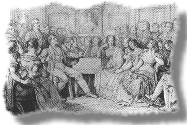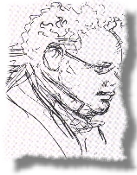|
|
Schubert, whose character
was humble and unassuming , was not recognized by his contemporaries
as he deserved, except in a circle of very close and affectionate
friends: a group of musicians, painters, cultured professionals
who sustained him, economically as well
The last three Piano Sonatas are all extensive works, where the classical form of the Sonata reaches its highest expansion, completing that period of transition that, beginning with the late works of Mozart, together with the revolutionary approach of Beethoven, leads to the nineteenth century Sonata. However Schubert's need to "sing" didn't break the scheme of the Sonata, but simply led to an extension of the form to include his "heavenly" lengths. He created a particular balance between rigorous classical form and a content already full of those expressive elements that became the basis of nineteenth century piano music. As we can see from the copy of the first page of the manuscript of the B flat major Sonata, the theme was conceived as a melodic line and only later was harmonically completed. This indicates that for Schubert melodic invention was a primary element, unlike Beethoven who strikes us with his extraordinary development of subjects, some of which are less interesting under a melodic profile. A rhythmic pulse unites and sustains the grand architecture of these works and through its constant motion every detail acquires significance, not only in itself but as part of the whole. Concerning this subject there is an interesting testimony of Leopold von Sonnleithner, one of the first to recognize Schubert's talent, who was often able to listen to him play and sing his own Lieder, or play them on the piano with the best singers of the time. In an article that was published in Vienna in 1860, complaining of the bad taste with which the Schubert Lieder were sung in the houses of Vienna, he wrote: " Schubert....demanded above all that his songs should not so much be declaimed as sung flowingly, that the proper vocal timbre should be given to every note,..... and that by this means the musical idea should be displayed in its purity. A necessary corollary to this is the strictest observation of the tempo. Schubert always indicated exactly where he wanted or permitted a ritardando, an accelerando or any kind of freer delivery. But where he did not indicate this he did not tolerate the slightest arbitrariness or the least deviation in tempo" (2). The Sonata in B flat
major, the last of the three published posthumously by Diabelli
in 1839, is a play between a light both serene and euphoric and
sad shadows filled with pain and doubt. The peaceful and melancholic
melody of the opening phrase of the first movement, Molto moderato,
followed by an unrestful and mysterious trill in the base, introduces
us immediately to Schubert's spirit: a serenity veiled by melancholy,
with moments of profound sadness followed by gentle simplicity,
as in the second theme that reminds us of a Viennese In a letter to his future wife Clara Wieck, dated december 11th 1839, the young Schumann writes: "....Clara, I was in a state of bliss today. At the rehearsal a simphony by Franz Schubert was played. If only you had been there. It is not possible to describe it to you; all the instruments are human voices; it is gifted beyond measure, and its instrumentation, Beethoven not withstanding- and this length, this heavenly length, like a novel in four volumes, longer than the ninth Symphony. I was completely happy and wished for nothing but that you might be my wife and that I, too, could write such Symphonies." (3) The Four Impromptus op. 90, written in December 1827 and published in Vienna by Diabelli in 1839, and the Six Moments Musicaux op. 94 composed between 1823 and 1828 and published in Vienna in 1828 by Leidesdorf, are brief compositions in a three part form and represent a more immediate and direct way of making music, less bound to the rigid scheme of the classical Sonata, and therefore more easily accessible to the large public.The Impromptus are more constructed and brilliant , the Moments Musicaux more intimate and meditative. These compositions anticipate the various short pianistic forms that developed in the nineteenth century: Mendelssohn's "Songs without words" ,the Chopin Impromptus, the various short pieces by Schumann and Brahms... We could define as"Lieder without words" the first and third Impromptus, with their extended melodic lines; the former with the repeated triplets that are typical of Lieder accompaniments, giving that Schubertian sense of unrestful motion; the latter with its gentle and passionate accompanied melody that unravels uninterrupted in a game of modulations and refined contrasts of sonorities. The other two are more brilliant and "pianistic"; however, the virtuoso technique is never an end in itself, but is always a part of musical expression. The Moments Musicaux
bring us to the more inward and poetical sphere of Schubert, and
are like entries in an intimate notebook of his soul. Short ideas
with short developments, all the more effective for their extreme
simplicity, these works were composed in a period of five years,
representing different moments of inspiration. The first, in C
major, has a character of imaginative improvisation. More meditative
the second in A flat major - in which the initial chords introduce
a climate of suspension and uncertainty, followed by an evocative
melody in C sharp minor that will be repeated with dramatic impetuosity
- and the sixth, in the same key, where the unresolved "appoggiature"
create a climate of unanswered questions. The fourth, in C sharp
minor, is a "moto perpetuo" that recalls a baroque prelude,
with a more melodic central episode, which returns pianissimo
for two bars in the Coda, thus creating a suspension of the inexorable
"moto perpetuo". The third, a characteristic Russian
dance, and the exuberant gallop of the fifth's unceasing rhythm
of repeated chords, both in F minor, open a more extrovert interlude
in this series of compositions that are characterized by calm
introspection. |
Official Web
Site by ANDREA PASSIGLI
piano
 as
spiritually, during all his life, marvelling at his musical genius
during those intimate evenings that were to become known as "Shubertiads".
There is no doubt that he was recognized mainly as a Lieder composer
for voice and piano, and his most important instrumental music,
in many cases published only after his death, was scarcely successful
amongst publishers who considered it not easy to sell.
as
spiritually, during all his life, marvelling at his musical genius
during those intimate evenings that were to become known as "Shubertiads".
There is no doubt that he was recognized mainly as a Lieder composer
for voice and piano, and his most important instrumental music,
in many cases published only after his death, was scarcely successful
amongst publishers who considered it not easy to sell. "Laendler". After
the sonorous explosion of the development the opening theme appears
again in a different light, transfigured and celestial. The same
happens to the sad and painful theme in C sharp minor of the
Andante sostenuto, accompanied by a dramatic syncopated figure
in the base, which in a brief parenthesis in the recapitulation
reappears in C major, suggestive of more serene horizons. We cannot
but think of the extraordinary Adagio of the string Quintet, composed
in the same period. In Schubert, suffering comes from a deep introspection
of the soul, and through its transformation and transfiguration
he reaches the serene joy of the spirit: this ethical and religious
conception, in accordance with the romantic spirit of the time,
is at the basis of the immediate human communicativeness that
still today renders Schubert's music so alive and vibrant. Also
the joyful liveliness of the Scherzo is contrasted by the
subtle melancholy of the Trio in B flat minor and in the Rondo
the sense of suspension, created by the beginning octave that
will be repeated throughout the movement, seems to take the upper
hand in the uncertain atmosphere of the few bars that precede
the final "stretto", almost raising a doubt as to the
euphoric vitality of the movement.
"Laendler". After
the sonorous explosion of the development the opening theme appears
again in a different light, transfigured and celestial. The same
happens to the sad and painful theme in C sharp minor of the
Andante sostenuto, accompanied by a dramatic syncopated figure
in the base, which in a brief parenthesis in the recapitulation
reappears in C major, suggestive of more serene horizons. We cannot
but think of the extraordinary Adagio of the string Quintet, composed
in the same period. In Schubert, suffering comes from a deep introspection
of the soul, and through its transformation and transfiguration
he reaches the serene joy of the spirit: this ethical and religious
conception, in accordance with the romantic spirit of the time,
is at the basis of the immediate human communicativeness that
still today renders Schubert's music so alive and vibrant. Also
the joyful liveliness of the Scherzo is contrasted by the
subtle melancholy of the Trio in B flat minor and in the Rondo
the sense of suspension, created by the beginning octave that
will be repeated throughout the movement, seems to take the upper
hand in the uncertain atmosphere of the few bars that precede
the final "stretto", almost raising a doubt as to the
euphoric vitality of the movement.